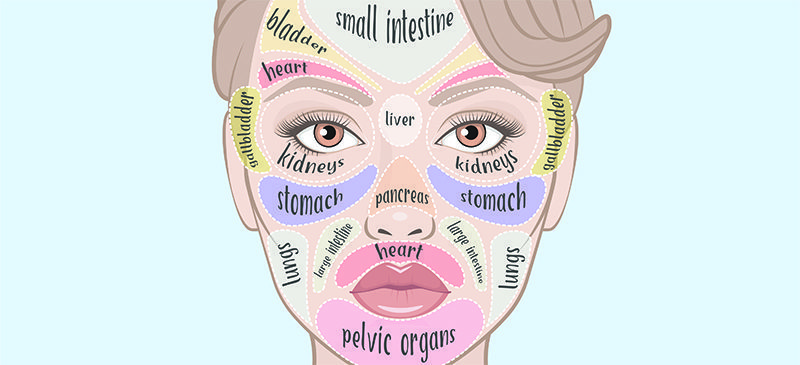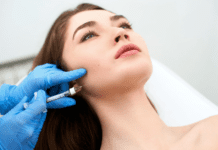Understanding What Your Skin Is Telling You About Your Health
Have you ever wondered why you get acne in the same spots on your face? Or why certain areas of your skin seem more prone to redness or dryness? The answer might lie in an ancient practice called face mapping.
What Is Face Mapping?
Face mapping is an ancient medicinal technique that connects problems on your face to your overall health. With roots going back thousands of years in Chinese medicine and Ayurvedic traditions, face mapping suggests that the location of skin issues on your face can reveal what’s happening inside your body, particularly with major organs like your kidneys, liver, and heart.
Think of your face as a roadmap to your internal health – when something’s off inside, it might show up as a skin problem in a specific area of your face.
The Ancient Origins of Face Mapping
Chinese Face Mapping Traditions
Chinese face mapping, also known as “mien shiang” (which means “face reading”), dates back at least 3,000 years. Similar to other Traditional Chinese Medicine practices like acupuncture, face reading is based on the belief that energy flows through the body along specific meridians.
When your “life force energy” (Qi) gets disrupted, Chinese medicine practitioners believe this disruption shows up on your face as breakouts, redness, or other skin issues. According to this tradition, practitioners can see reflections of your body’s organs by observing your face’s complexion, including its luster, dullness, and color.
Ayurvedic Face Mapping
While similar to Chinese face mapping, Ayurvedic face mapping differs in which organs influence different parts of the face. Ayurveda focuses more on your dosha (your genetically determined body type) rather than manipulating energy meridians.
According to Ayurvedic principles, your personality type and body constitution affect your skin health. Some people benefit from cooling, calming practices like eating more raw foods and gentle exercise, while others need more heat-building activities like eating spicy foods and vigorous exercise.
How Face Mapping Works
Face mapping divides your face into at least 10 different zones, with each zone linked to specific organs or body systems. By examining skin issues in these zones, practitioners aim to identify underlying health problems.
The Basic Face Map: What Each Zone Means
Here’s what different areas of your face might be telling you about your health:
Forehead Zone
Blemishes on your forehead might be connected to your small intestine and bladder. They could also signal unmanaged stress, poor digestion, or sleep deprivation. The forehead is also linked to stress and diet according to acne face mapping.
Between and Above Eyebrows
Breakouts in this area might represent an imbalance in your kidneys, stomach, bladder, or spleen[1]. When acne develops near your nostrils, it could be tied to gut problems and small intestine inflammation.
Lines Between Eyebrows
Wrinkles between your eyebrows on the right side might indicate repressed emotions like anger, possibly tied to poor liver function. Lines on the left side may represent problems with your liver and spleen functions.
Above the Eyebrows
Breakouts or lines above your eyebrows could represent heart function issues.
Under-Eye Area
Puffiness under your eyes is said to be connected to poor kidney function.
Chin, Mouth, and Jaw
Acne in these areas might be due to imbalances in your reproductive system, large intestine, colon, and stomach. When acne forms below your lips and lower chin, it might indicate that your digestive system as a whole isn’t functioning properly, including your spleen and kidneys.
Cheeks
Red cheeks can be tied to stomach, liver, and lungs dysfunction. They might also indicate an immune response, respiratory issues, or allergies.
Nose
A red nose might indicate heart-related issues like high blood pressure and inflammation.
Neck
Irritation on your neck can represent stress affecting your immune system.
The Science Behind Face Mapping
While face mapping has ancient roots, what does modern science say about it? Overall, scientific evidence supporting traditional Ayurvedic and Chinese face mapping is limited. However, some research does show that certain skin conditions appearing in particular facial areas may indeed be linked to issues like hormonal imbalances, stress, or immune reactions.
A 2019 study noted that there are “distinct regional differences in transepidermal water loss, capacitance, blood flow, sebum, pH and temperature” in facial skin, suggesting that different parts of the face may indeed respond differently to lifestyle factors.
Modern Dermatological Perspective
Modern dermatology identifies several root causes of facial skin conditions:
- Hormonal imbalances (especially androgenic hormones like testosterone)
- High-stress levels
- Excessive oil production, particularly in the T-zone
- Poor sleep habits
- Inadequate hygiene
- Poor gut health
- Allergies and immune responses
- Reactions to makeup and skincare products
- Genetic factors
- Sun exposure
- Poor circulation
- Underlying diseases like diabetes or heart disease
- Environmental irritants
Many of these causes align with traditional face-mapping principles, suggesting some overlap between ancient wisdom and modern understanding.
Face Mapping in Modern Practice
Dermalogica’s Approach to Face Mapping
Dermalogica offers a modern face-mapping approach, combining ancient Chinese diagnoses with science-based knowledge. Their Face Mapping® service involves examining your skin with a trained eye, touching it, and asking about your lifestyle and environment.
While their approach overlaps with traditional methods, Dermalogica focuses more on factors like hormonal fluctuations, product irritation, sun exposure, and dehydration. Their recommendations often include:
- Avoiding irritating fragrances and skincare products
- Removing pore-clogging makeup and cosmetics
- Preventing sun damage
- Staying hydrated
- Managing stress
- Eating a balanced diet
- Addressing food allergies
- Avoiding bacteria from phones and dirty pillowcases
Acne Face Mapping
Acne face mapping is one of the most popular applications of this theory. This approach suggests that recurring acne in specific facial locations has particular causes. For example, most practitioners believe that:
- Acne on the forehead represents kidney or digestive issues
- Acne on the chin and jaw indicates intestinal and colon dysfunction, hormonal imbalances, and high stress levels
According to Amanda Caldwell of U.S. Dermatology Partners, “Many people take a one-size-fits-all approach to caring for acne skin, but there are many different underlying causes of acne that require unique treatment approaches.” While not foolproof, acne face mapping “accurately represents common acne development patterns.”
Should You Try Face Mapping?
The bottom line on face mapping? While it isn’t supported by solid scientific evidence, it isn’t considered risky either. Face mapping might be worth exploring if other treatments haven’t worked well for your skin issues.
Most dermatologists recommend starting with the basics before turning to face mapping:
- Clean your face regularly with gentle, appropriate products
- Use SPF when in the sun
- Treat any existing skin infections
- Remove known allergens from your diet and lifestyle
Consulting with a face mapping specialist might provide additional insights if you already practice good hygiene and eat a balanced diet but still have ongoing skin issues.
Face Mapping for Professionals
For skincare professionals, face mapping can be a valuable tool for developing customized treatment plans. It allows estheticians to analyze different facial zones and pinpoint areas needing special attention.
By examining irregularities like uneven pigmentation, redness, congestion, or wrinkles, professionals can create personalized skincare regimens tailored to individual needs. This approach can be constructive for difficult-to-treat skin conditions.
Final Thoughts
Face mapping offers an intriguing lens to view the connection between your skin and overall health. While not scientifically proven, this ancient practice provides a framework for understanding how internal issues might manifest externally.
Whether you’re dealing with persistent acne, unexplained redness, or other skin concerns, face mapping might offer new perspectives on potential underlying causes. Combined with modern skincare practices and medical advice, it could be one more tool in your journey toward healthier skin and better overall wellness.
Remember that your skin often reflects what’s happening inside your body. By paying attention to these signals and addressing root causes rather than just symptoms, you might find more lasting solutions to your skin concerns.
Have you noticed patterns in where your skin issues appear? Maybe it’s time to look deeper than just the surface.









